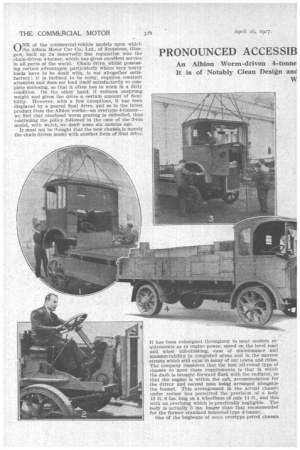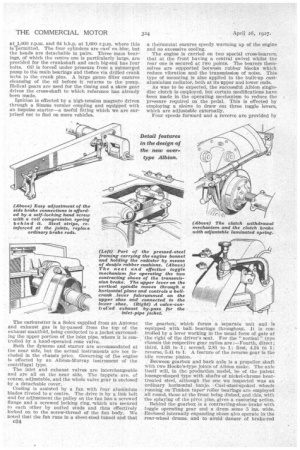PRONOUNCED ACCESSIB 'Y IN A NEW OVERTYPE.
Page 54

Page 55

Page 56

Page 57

If you've noticed an error in this article please click here to report it so we can fix it.
ONE of the commercial-vehicle models upon which the Albion Motor Car Co., Ltd., of Scotstoun, Glasgow, built up its deservedly fine reputation was the chain-driven 4-twiner, which has given excellent service in all parts of the world. Chain drive, whilst possessing certain advantages, particularly where very heavy loads have to be dealt with, is not altogether satisfactory; it is inclined to be noisy, requires constant attention and does not lend itself satisfactorily to complete enclosing, so that it often has to work in a dirty condition. On the other hand, it reduces unsprung weight and gives the drive a certain amount of flexibility. However, with a few exceptions, it has been displaced by a geared final drive, and so in the latest product from the Albion works—an overtype 4-tonnerwe find that overhead worm gearing is embodied, thus continuing the policy followed in the case of the 3-ton model, with which,we dealt some six months ago.
It must not be thought that the new chassis is merely the chain-driven model with another form of final drive.
It has been redesigned throughout to meet modern requirements as to engine power, speed on the level road and when hill-climbing, ease of maintenance and manceuvrability in congested areas and in the narrow streets which still exist in many of our towns and cities. The company considers that the best all-round type of chassis to meet these requirements is that in which the dash is brought forward flush with the radiator, so that the engine is within the cab, accommodation for the driver and second man being arranged alongside the bonnet. This arrangement in the actual chassis under review has permitted the provision of a body 13 ft. 6 ins, long on a wheelbase of only 11 ft., and this with an overhang which is practically negligible. The body is actually 0 ins, longer than that recommended for the former standard bonneted-type 4-tonner.
One of the bugbears of some overtype petrol chassis
is the decreased accessibility to important parts of the engine and to the unit as a whole._ In the new Albion this matter has received the greatest consideration and all the important auxiliaries are at the near side, and the magneto, which is driven in conjunction' with the centrifugal water piimp by a cross-shaft, presents its contact breaker for easy and instant inspection or adjustment. In addition, the near-side panel of the bonnet lifts out and the top is hinged so that it can be raised to a vertical position. Perhaps more important still is the means whereby access is afforded to the whole unit. This takes the form of a cab which can be removed in its entirety within six minutes by two men employing a light lifting tackle.
The cab does not have to be lifted far to clear the engine and radiator, for a large portion of the back is a permanent fixture on the chassis and the gap left as the cab is withdrawn provides the clearance necessary. The permanent portion also serves as a means for securing the cab, which is additionally held by two bolts passing through brackets mounted at the sides of the dumb-irons or, rather, the front ends of the frame side members, for there are no dumb-irons in the generally accepted meaning of the term. Removal of the cab should be seldom necessary, for practically all adjustments and small repairs can be carried ort with the cab in position. The instrument board is a fixture on the chassis, being supported direct from the side members by sheet-steel brackets, and bayonet connections are provided for the cables running to the headlamps which are secured to, and partly socketed into, the dash.
With a turning circle of only 45 ft. diameter, this model should prove an excellent one for work in docks, narrow roads with sharp turnings and for municipal transport. Its appearance is most striking, for the front of the radiator is Shaped to a blunt Vee to conform with the dash, and with 'a lorry body the vehicle bears some resemblance to a boat ; there is none of that top-heaviness which so often characterizes the forwarddash type, and a curved canopy adds to the general good effect.
To meet different conditions of service, the new standard 4-tonner is being marketed in three types, varying only in the maximum engine speed and finaldrive gear ratio. The " normal " home type has a ratio of 6a to 1 and is governed to 1,400 r.p.m., which gives 20 m.p.h. The " arduous " home type is geared to 81to 1, the maximum speed again being 20 m.p.h., but the engine in this instance is governed to 1,600 r.p.m. Finally, there is the " colonial " type, with a gear ratio of 8i to 1 and a maximum speed of 161 m.p.h. at 1,400 -r.p.m.
Each engine is of 34 h.p. by R.A.C. rating and has a bore of 4i ins, and a stroke of 51 ins., giving 43 b.h.p.
at 1,000 r.p.m. and 64 b.h.p. at 1,600 r.p.ixt. where this is*'permitted. The four cylinders are east en ‘bloc, but the heads are detachable in pairs. Three main bearings, of which the centre one is particularly large, are provided for the crankshaft and each big-end has four bolts. Oil is forced under pressure from a submerged pump to the main bearings and thence via drilled crank webs to the crank pins. A large gauze filter ensures cleansing of the oil before it returns to the pump. Helical gears are used for the timing and a skew gear drives the cross-shaft to which reference has already been made.
Ignition is effected by a high-tension magneto driven through a Simms vernier coupling and equipped with an impulse starter—a useful fitting which we are surprised not to find on more vehicles.
The carburetter is a Solex supplied from an Autovae and exhaust gas is by-passed from the top of the exhaustnianifold, being conducted to a jacket surrounding the upper portion of the inlet pipe, where it is controlled by a hand-operated cone valve.
Both the dynamo and starter are accommodated at the near side, but the actual instruments are not included in the chassis price. Governing of the engine is effected by an Albion-Murray instrument of the centrifugal type.
The inlet and exhaust valves are interchangeable and are all on the near side. The tappets are, of course, adjustable, and the whole valve gear is enclosed by a detachable cover.
Cooling is assisted by a fan with four aluminium blades riveted to acentre. The drive is by a link belt and for adjustment the pulley on the fan has a screwed flange and a screwed locking ring, -which are secured to each other by nufted studs and thus effectively locked on to the screw-thread of the fan body. We noted that the fan runs in a sheet-steel tunnel and that c34
a thermostat ensures speedy warming up of the engine and no excessive cooling.
The engine is carried on two special cross-bearers, that at the front having a central swivel whilst the rear one is secured at two points. The bearers themselves are supported between rubber blocks which reduce vibration and the transmission of noise. This type of mounting is also applied to the built-up castaluminium radiator, both at its upper and lower ends.
As was to be expected, the successful Albion singledisc clutch is employed, but certain modifications have been made in the operating mechanism to reduce the pressure required on the pedal. This is effected by employing a sleeve to draw out three toggle levers, which are adjustable externally.
Four speeds forward and a reven:e are provided by the gearbox, which forms a separate unit and 18 equipped with ball bearings throughout. It is controlled by a lever working in the usual form of gate at ,the right of the driver's at. For the " northal " type chassis the respective gear ratios are :—Fourth, direct ; third, 1.63 to 1; second; 2,81 to 1; first, 4.24 to 1; reverse, '5.41 to 1. A feature of the reverse gear is the idle reverse pinion.. • Between gearbox and back axle is a propeller shaft with two Hooke's-type joints of Albion make. The axle itself will, in the production model, be of the patent lozenge-shaped type with shafts of nickel-chrome heattreated steel, although the one we inspected was an ordinary horizontal banjo. Cast-steel-spoked wheels running on Timken taper roller bearings are employed all round, those at the front being dished, and this, with the splaying of the pivot pins, gives a castoring action.
Behind the gearbox is a contracting-shoe-brake with toggle operating gear and a drum some 5 ins. wide. Enclosed internally expanding shoes ah:o operate in the rear-wheel drums, and to avoid danger of brake-rod
fractures twin strips of steel, reinforced at the pin-holes to prevent cutting the pins, are employed for the connections to the brake lever.
As regards the frame, this is tapered slightly to front and rear, but is otherwise straight.
The worm-and-segment steering gear iS mounted on taper roller bearings; it is so positioned above the offside front spring that there is no pull on the steering as the axle rises and falls. Incidentally, the ground clearance is 10 ins. In a recent test of this chassis with a gross load of 8 tons 15 cwt., it climbed 1 in 7 in second gear with a little reserve in hand, 1 in 15 in third gear with ample reserve and 1 in 30 quite easily in top gear.
Normal tyre equipment is 140 ram. for 720 rum. rims single solids at the front and 130 mm. for 720 mm. rims twin solids tit the rear.
The price of this chassis with paraffin side and tail lamps and the usual mileage recorder driven from the gearbox is £775 (ex works).












































































































